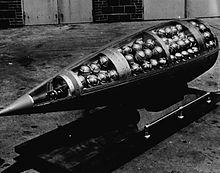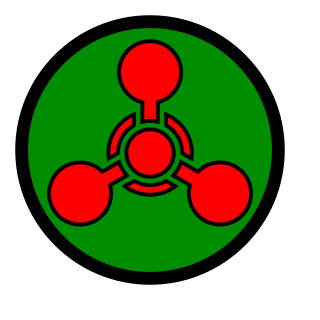History
The U.S. had participated in the formulations of the Hague Conventions of 1899 and 1907 which banned chemical warfare, among other things, but the U.S. never joined the article which prohibited chemical weapons.
World War I
In World War I, the U.S. established its own chemical weapons research facility and produced its own chemical munitions. [2] It produced 5,770 metric tons of these weapons, including 1,400 metric tons of phosgene and 175 metric tons of mustard gas. This was about 4% of the total chemical weapons produced for that war and only just over 1% of the era's most effective weapon, mustard gas. (U.S. troops suffered less than 6% of gas casualties.) [3] The U.S. also established the First Gas Regiment, which left Washington, D.C., on Christmas Day, 1917, and arrived at the front in May 1918. [2] During its time in France, the First Gas Regiment used phosgene in a number of attacks. [4]
The United States began large-scale production of an improved vesicant gas known as Lewisite, for use in an offensive planned for early 1919. Lewisite was a major American contribution to the chemical weapon arsenal of World War I, although it was not actually used in the field during World War I. It was developed by Captain Winford Lee Lewis of the U.S. Chemical Warfare Service in 1917. [3] (The Germans later claimed that they had manufactured it in 1917 prior to the American discovery.) By the time of the armistice on 11 November 1918, a plant near Willoughby, Ohio, was producing 10 tons per day of the substance, for a total of about 150 tons. [3] It is uncertain what effect this new chemical agent would have had on the battlefield, however, as it degrades in moist conditions. [5] [6]
After the war, the U.S. was party to the Washington Arms Conference Treaty of 1922 which would have banned chemical weapons but failed because it was rejected by France. The U.S. continued to stockpile chemical weapons, eventually exceeding 30,000 tons of material.
World War II
Chemical weapons were not used by the U.S. or the other Allies during World War II; however, quantities of such weapons were deployed to Europe for use in case Germany initiated chemical warfare. At least one accident occurred: On the night of December 2, 1943, German Junkers Ju 88 bombers attacked the port of Bari in Southern Italy, sinking several American ships – among them John Harvey, which was carrying mustard gas. The presence of the gas was highly classified, and authorities ashore had no knowledge of it – which increased the number of fatalities, since physicians, who had no idea that they were dealing with the effects of mustard gas, prescribed treatment not consistent with those suffering from exposure and immersion. According to the U.S. military account, "Sixty-nine deaths were attributed in whole or in part to the mustard gas, most of them American merchant seamen" out of 628 mustard gas military casualties. [Navy 2006] [Niderost] Civilian casualties were not recorded. The whole affair was kept secret at the time and for many years after the war. Large quantities of chemical weapons were also deployed to India, from where they could have been delivered to Japan by B-29 bombers. At the end of the war, over 50,000 mustard gas bombs, 10,000 phosgene bombs and other chemical munitions were dumped into deep water in the Bay of Bengal. [7]
The US military conducted experiments with chemical weapons like lewisite and mustard gas on Japanese American, Puerto Rican and African Americans in the US military in World War II to see how non-white races would react to being mustard gassed, with Rollin Edwards describing it as "It felt like you were on fire, Guys started screaming and hollering and trying to break out. And then some of the guys fainted. And finally they opened the door and let us out, and the guys were just, they were in bad shape." and "It took all the skin off your hands. Your hands just rotted". White soldiers were not experimented on. [8]

Cold War
After the war, the Allies recovered German artillery shells containing three new nerve agents developed by the Germans (Tabun, Sarin, and Soman), prompting further research into nerve agents by all of the former Allies. Thousands of American soldiers were exposed to chemical warfare agents during Cold War testing programs (see Edgewood Arsenal human experiments), as well as in accidents. In 1968, one such accident killed approximately 6,400 sheep when an agent drifted out of Dugway Proving Ground during a test. [9]
The U.S. also investigated a wide range of possible nonlethal, psychobehavioral chemical incapacitating agents including psychedelic indoles such as lysergic acid diethylamide (also experimenting to see if it could be used for effective mind control) and marijuana derivatives, certain tranquilizers like ketamine or fentanyl, as well as several glycolate anticholinergics. One of the anticholinergic compounds, 3-quinuclidinyl benzilate, was assigned the NATO code BZ and was weaponized at the beginning of the 1960s for possible battlefield use. This agent was allegedly employed by American troops as a counterinsurgency weapon in the Vietnam War but the U.S. maintains that this agent never saw operational use. [10] The North Koreans and Chinese have alleged that chemical and biological weapons were used by the United States in the Korean War; [11] but the United States' denial is supported by Russian archival documents. [12]
The growing protests over the U.S. role in the Vietnam War, the use of defoliants there, and the use of riot control agents both in Southeast Asia and inside the U.S. (as well as heightened concern for the environment) all gradually increased public hostility in the U.S. toward chemical weapons in the 1960s. Three events particularly galvanized public attention: a 1968 sheep-kill incident at Dugway Proving Ground, Operation Cut Holes and Sink ‘Em (CHASE) — a program involving disposal of unwanted munitions at sea — and a 1969 accident with sarin at Okinawa. [13]
Renunciation
On November 25, 1969, President Richard Nixon unilaterally renounced the first use of chemical weapons and renounced all methods of biological warfare. [14] He issued a unilateral decree halting production and transport of chemical weapons which remains in effect. From 1967 to 1970 in Operation CHASE, the U.S. disposed of chemical weapons by sinking ships laden with the weapons in the deep Atlantic. The U.S. began to research safer disposal methods for chemical weapons in the 1970s, destroying several thousand tons of mustard gas by incineration at Rocky Mountain Arsenal and nearly 4,200 tons of nerve agent by chemical neutralization at Tooele Army Depot and Rocky Mountain Arsenal. [15]
The U.S. entered the Geneva Protocol in 1975 at the same time it ratified the Biological Weapons Convention. This was the first operative international treaty on chemical weapons that the United States was party to.
In May 1991, President George H. W. Bush unilaterally committed the United States to destroying all chemical weapons and renounced the right to chemical weapon retaliation. In 1993, the United States signed the Chemical Weapons Convention, which required the destruction of all chemical weapon agents, dispersal systems, and chemical weapons production facilities by April 2012. In 1997, the United States formally agreed to destroy its stockpile by ratifying the Chemical Weapons Convention. The international treaty bans the use of all chemical weapons and aims to eliminate them throughout the world.

Decommissioning and destruction
The U.S. began stockpile reductions in the 1980s, removing some outdated munitions and destroying its entire stock of BZ beginning in 1988. In June 1990, Johnston Atoll Chemical Agent Disposal System began destruction of chemical agents stored on Johnston Atoll in the Pacific, seven years before the Chemical Weapons Convention came into effect. In 1986, President Ronald Reagan made an agreement with Chancellor Helmut Kohl to remove the U.S. stockpile of chemical weapons from Germany. As part of Operation Steel Box, in July 1990, two ships were loaded with over 100,000 shells containing GB and VX taken from U.S. Army weapons storage depots such as Miesau and then-classified ammunition FSTS (forward storage/transportation sites) and transported from Bremerhaven, Germany, to Johnston Atoll in the Pacific, a 46-day nonstop journey. [16]
The U.S. prohibition on the transport of chemical weapons as part of the Chemical Weapons Convention meant that destruction facilities had to be constructed at each of the U.S. nine storage facilities.
Congress established the Assembled Chemical Weapons Assessment (ACWA) program in 1996 to safely test and demonstrate at least two alternative technologies to the baseline incineration process for the destruction of the nation’s remaining stockpile of assembled chemical weapons. [17] Beginning in 1999, ACWA was tasked by the Secretary of Defense to demonstrate six incineration alternatives to destroy the remaining U.S. chemical weapons stockpile stored at the Blue Grass Army Depot in Kentucky and the U.S. Army Pueblo Chemical Depot in Colorado, the final two stockpiles in the United States. By 2000, ACWA had demonstrated six technologies. Neutralization followed by biotreatment was selected for the Colorado stockpile, and neutralization followed by supercritical water oxidation was selected for the Kentucky stockpile.
The U.S. met the first three of the treaty's four deadlines, destroying 45% of its stockpile of chemical weapons by 2007. By January 2012, the final treaty deadline, the United States had destroyed 89.75% of the original stockpile. [18] Only the stockpiles in Kentucky and Colorado remained. The final chemical weapon was not destroyed until July 7, 2023. [19] [20] [21]













